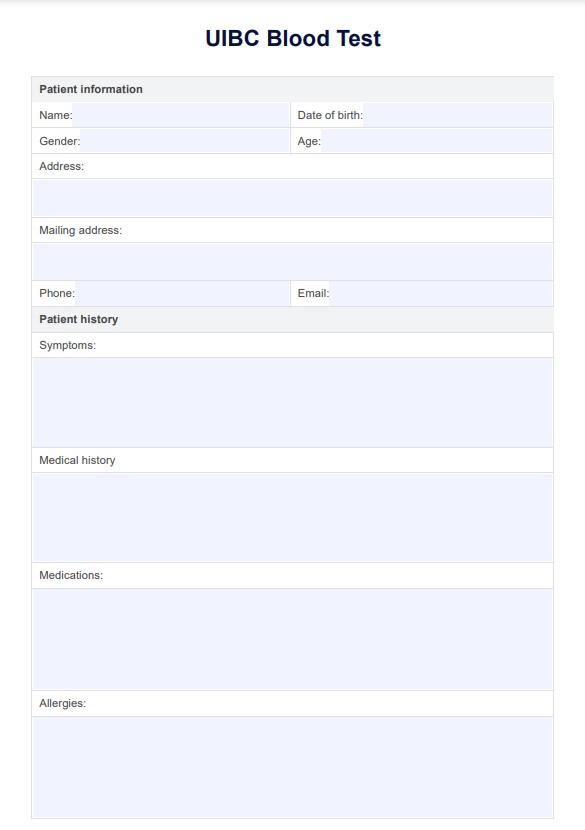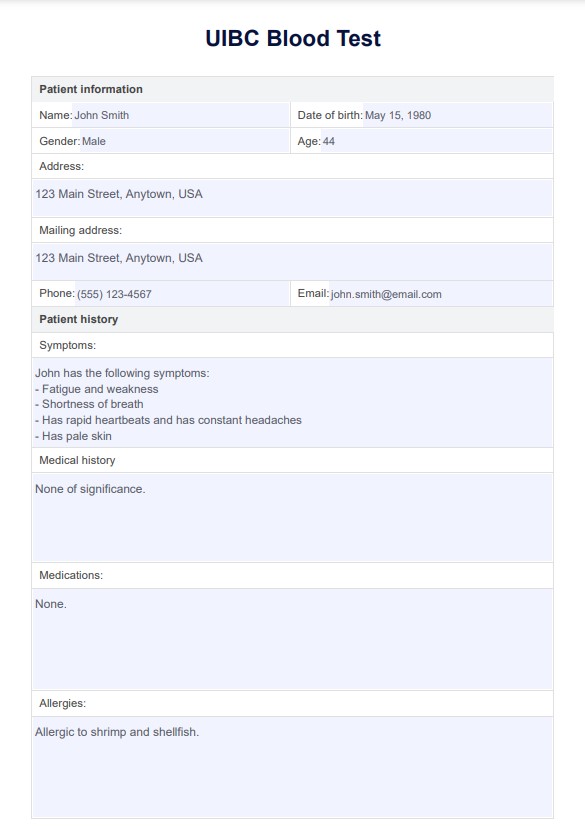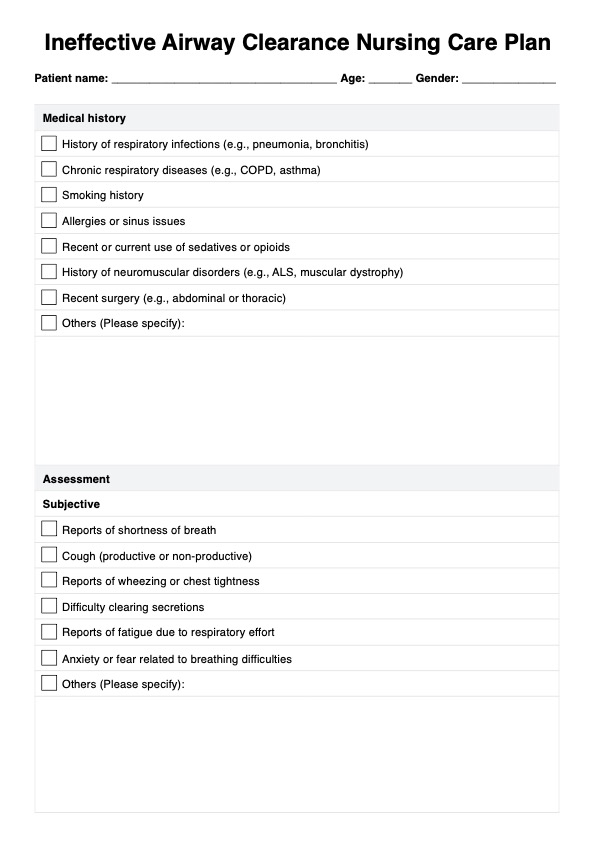UIBC Blood
Learn about the purpose of a UIBC Blood Test and what to do with the results through this guide!


What is a UIBC Blood Test?
A UIBC Blood Test, or Unsaturated Iron-Binding Capacity Test, is a diagnostic tool for assessing the body's ability to transport and store iron. Iron is an essential mineral for various bodily functions, including producing red blood cells and maintaining overall health. UIBC is one of several markers measured in a comprehensive iron panel to evaluate an individual's iron status.
The UIBC test measures the amount of transferrin in the blood to bind with additional iron. Transferrin is a protein. Its responsibility is to transport iron throughout the body, and its capacity to bind iron is a key factor in regulating iron levels. When iron stores in the body are low, transferrin levels increase, resulting in a higher UIBC value. Conversely, when iron stores are high, transferrin levels decrease, leading to a lower UIBC value.
Doctors typically order a UIBC Blood Test in conjunction with other tests like serum iron, total iron-binding capacity (TIBC), and ferritin to gain a comprehensive understanding of a patient's iron status. These tests help diagnose various iron deficiency or overload conditions, such as anemia or hereditary hemochromatosis.
Interpreting the results of a UIBC Blood Test can provide valuable insights into a patient's iron metabolism and guide treatment decisions. If UIBC levels are elevated, it may indicate iron deficiency anemia. At the same time, low UIBC values could indicate conditions like hemochromatosis or chronic liver disease, where the body absorbs too much iron.
UIBC Blood Template
UIBC Blood Example
How does it work?
Step 1: Medical consultation
The first step is to determine whether a UIBC Blood Test is necessary based on the patient's symptoms, medical history, and physical examination. If it is, an appointment should be scheduled.
Step 2: Blood sample collection
The patient may be advised to fast for 12 hours before the test. On the date of the test, a phlebotomist or nurse will then collect a blood sample, typically from a vein in the arm, using a needle and a vacutainer tube.
Step 3: Sample processing
The collected blood sample is processed in a clinical laboratory. A serum or plasma is separated from the blood for analysis.
Step 4: Measurement of UIBC
The laboratory technician measures the unsaturated iron-binding capacity (UIBC) in the patient's blood sample. This is often done using a chemical assay or automated analyzer. The UIBC represents the amount of transferrin available to bind with iron.
Step 5: Interpretation and reporting
The laboratory generates a report with the UIBC value, typically expressed in micrograms per deciliter (µg/dL) or other appropriate units. The healthcare provider interprets the results regarding the patient's overall health and the clinical picture.
Next steps
Clinical assessment and treatment
The healthcare provider analyzes the UIBC results and other iron-related markers like serum iron, TIBC, and ferritin.
Treatment decisions, if necessary, are made based on the diagnosis. Elevated UIBC may suggest iron deficiency anemia, while low UIBC could indicate iron overload conditions.
Follow-up and monitoring
Patients may undergo additional UIBC Blood Tests to monitor their response to treatment or to track their iron status over time.
It is important to note that while printable UIBC Blood Test request forms are typically available for patients, the blood sample collection and analysis are conducted by healthcare professionals in a clinical setting. Patients should follow their healthcare provider's instructions regarding fasting and any other pre-test requirements to ensure accurate results.
When would you conduct this test?
The UIBC Blood Test, or Unsaturated Iron-Binding Capacity Test, is a valuable diagnostic tool used in various clinical scenarios to assess a patient's iron status and identify iron-related disorders that affect iron metabolism, transferrin saturation, etc. Here are some critical situations when healthcare practitioners may use this test:
- Anemia diagnosis: UIBC Blood Tests are frequently employed to help diagnose anemia. When patients present with symptoms such as fatigue, weakness, and pallor, a healthcare provider may order this test to determine if the anemia is related to iron deficiency. Elevated UIBC levels often indicate insufficient iron for hemoglobin production, a common cause of anemia.
- Iron saturation detection: In cases where there is a suspicion of iron overload conditions like hereditary hemochromatosis, the UIBC test can be used with other iron markers to assess the body's iron balance. Low UIBC levels can indicate excessive iron accumulation in the body, which may lead to organ damage.
- Chronic diseases: Patients with chronic inflammatory diseases, such as rheumatoid arthritis or chronic kidney disease, may experience anemia due to the body's inability to utilize iron effectively. The UIBC Blood Tests can help in diagnosing this type of anemia.
- Monitoring treatment: For individuals undergoing iron supplementation or treatment for iron-related disorders, healthcare practitioners may use UIBC tests to monitor the effectiveness of treatment and adjust the therapy as needed. A decrease in UIBC may suggest that the treatment addresses the underlying iron deficiency.
- Preoperative assessment: In preparation for surgical procedures, healthcare providers may order a UIBC test to evaluate a patient's iron status. This helps ensure the patient is in the best condition for surgery and can tolerate potential blood loss.
- General health checkups: UIBC Blood Tests can be included in routine health checkups to assess an individual's overall iron status. This may be particularly relevant for individuals at risk of iron deficiency, such as pregnant women, children, and vegetarians.
What do UIBC Blood Test results mean?
Interpreting the results of a UIBC Blood Test, or Unsaturated Iron-Binding Capacity test, is crucial for assessing a person's iron status and diagnosing various iron-related disorders. Here are what the results may mean:
Normal UIBC
In healthy individuals with an adequate iron supply, UIBC levels are typically within the normal range. This suggests that the body has a balanced iron status.
Elevated UIBC
Iron deficiency anemia: High UIBC levels signify low iron levels in the body, eventually causing iron deficiency anemia. Ample unbound transferrin is available to bind with iron as the body tries to compensate for low iron stores.
Low UIBC
Iron erload: Low UIBC values may indicate iron overload conditions such as hereditary hemochromatosis or chronic liver disease. In these cases, the body absorbs and stores excessive iron, decreasing unbound transferrin levels.
It is important to note that UIBC results are often evaluated in conjunction with other iron-related markers to provide a comprehensive assessment of iron status:
- Serum iron: This measures the concentration of iron in the blood and helps in understanding the current iron level in the body.
- Total iron-binding capacity (TIBC): TIBC assesses the maximum amount of iron transferrin the body can carry, providing insights into its iron-carrying capacity.
- Ferritin: Ferritin is a protein that stores iron. Low ferritin levels can be indicative of depleted iron stores.
Ultimately, healthcare providers use the collective information from these tests to make a diagnosis and determine the appropriate course of action:
- In cases of iron deficiency, supplementation or dietary changes may be recommended to boost iron levels.
- In situations of iron overload, therapeutic phlebotomy (removing excess blood) may be necessary to reduce iron levels and prevent complications.
A UIBC Blood Test can reveal necessary information about iron metabolism. Consult a healthcare provider for appropriate tests and guidance regarding iron-related conditions and overall health.
Commonly asked questions
Healthcare providers, including doctors, hematologists, and other specialists, typically request a UIBC Blood Test to assess a patient's iron status and diagnose iron-related disorders.
UIBC Blood Tests are used when there are symptoms of anemia, suspected iron deficiency, or iron overload conditions or as part of routine health checkups and preoperative assessments.
A blood sample is collected from a patient, and the serum or plasma is separated and analyzed in a clinical laboratory to measure Unsaturated Iron-Binding Capacity (UIBC) levels. The results are interpreted in the context of other iron-related markers to diagnose and manage iron-related conditions.















































































































